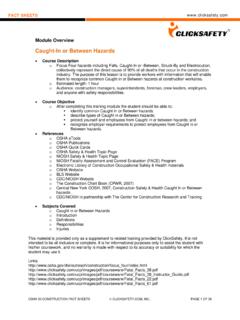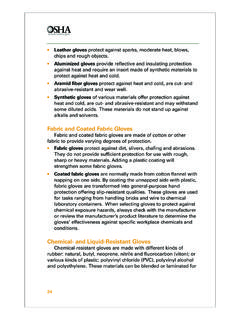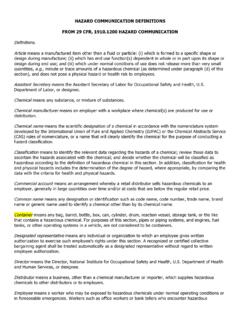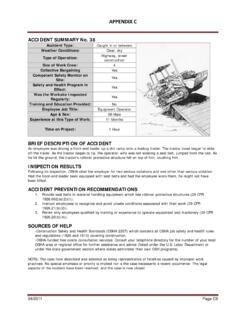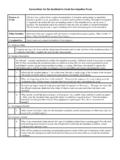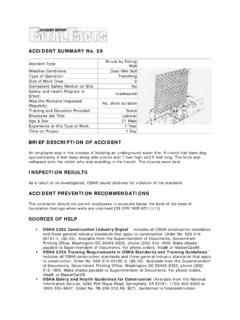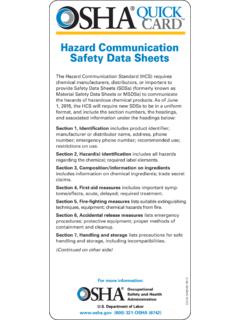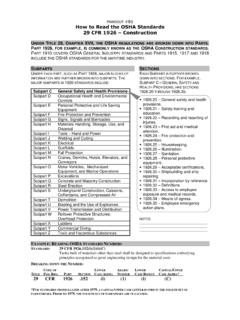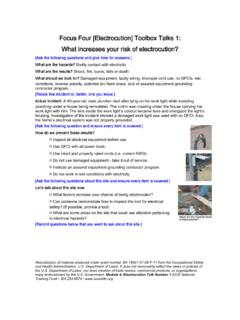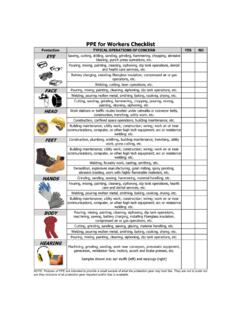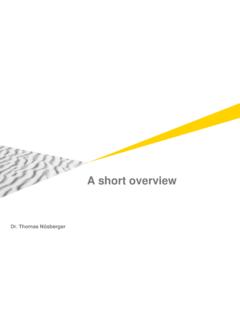Transcription of Overview - ClickSafety
1 Overview Introduction to Soils Safety Module Description Training in soil analysis and classification for safety during construction involving excavation and earth-moving activities. Topics will include competent person, soil properties and soil stressors, soil classification and soil testing. Estimated Length: 45 minutes Audience: Supervisors / Managers/Competent Person candidates Overview Course Objective Upon completion, the student should understand: Fed-OSHA Excavation Standard and the application of the standard with respect to soil safety, soil mechanics, soil classification. The role of the competent person regarding soil analysis and excavation safety. And be able to use several visual tests and manual tests in the analysis and classification of soil and be able to identify soil stressors and their effects.
2 Overview References Fed-OSHA Excavation Standard: 29 CFR. 1926 Appendix A of Subpart P describing: Tests to identify soils and soil conditions Work requirements This standard applies to: Sloping or benching systems Timber shoring Aluminum hydraulic shoring And other protective systems Overview Get Site-Specific Training! This training session: Provides basic occupational safety and health information. Is not a substitute for knowledge of OSHA or other standards. Is not a substitute for site-specific, hands-on training and information. Overview Your Competence is Critical Trenching & Excavation is Hazardous Work: Excavation allows forces previously held in equilibrium to act upon the exposed cut, and may result in the collapse of extremely heavy loads due to the lack of support.
3 Appendix A to subpart P describes a method of classifying soil and rock deposits based on site and environmental conditions, and on the structure and composition of the earth deposits. Overview Case Study Fatal Fact No. 31 Which of the following was a contributing factor to the cave-in? Proper shoring - wrong Vibration of nearby equipment correct Good soils testing - wrong Which of these did OSHA recommend? Keep excavated material 2 feet from excavation - correct Hire an expert soils tester wrong Protect walls to prevent cave-ins - correct Employers must instruct employees on hazard recognition and regulations- correct Provide ladder if trench 4 feet or more in depth - correct Competent Person Competent Person OSHA defines a Competent Person as: One who is capable of identifying existing and predictable hazards in the surroundings or working conditions which are unsanitary, hazardous, or dangerous to employees AND who has the authority to take prompt corrective measures to eliminate them.
4 Competent Person Competent Person The competent person must know: General protection requirements Soil classification Protective systems Only the employer can give an employee the competent person authority to correct a hazard. Special Note: Competent Person does not have to be a Superintendent, Foreman, or Project Manager. Competent Person Competent Person When competent person identifies: Possible cave-in. Failure of protective system. Hazardous atmosphere or other conditions. Competent Person removes employees until precautions have been taken to ensure their safety. Competent Person Why Classify Soil? Competent Person Must: Know soil types, properties, and OSHA soil classifications. Accurately recognize existing and potential hazards.
5 Select appropriate protective system. Use at least one visual qualitative test, and one manual quantitative test. Have ability to Read Soil and Environmental conditions for the safety of you and your co-workers! Competent Person Soil What is Soil? soil is made up of gravel, organic matter, clay, silt, and sand. Gravel: Generally the largest particles in soil. Larger than 2 millimeters in size. Silt: Particles smaller than millimeters. But larger than millimeters Sand: Smaller than Gravel. Smaller than 2 millimeters but larger than millimeters. Clay: Particles smaller than millimeters. Competent Person Soil Classification System OSHA Excavation Standard: Basis for selecting protective systems. Not the only classification system, but most common.
6 Most engineered systems are designed to meet this requirement. Competent Person needs to accurately recognize existing and potential hazards. Competent Person Authority The competent person must: Know general protection requirements Know soil classification Know protective systems Have authority to correct a hazard Who may give the competent person the authority to correct hazards? His trainer or employer - wrong Only his trainer - wrong OSHA or his employer - wrong Only his employer - correct Soil Properties Cemented soils Characteristics: Different soil components result in different soil properties. For example, Cemented soil means a soil in which the particles are held together by a chemical agent, such as calcium carbonate. A hand size sample cannot be crushed into powder, or individual soil particles, by finger pressure.
7 Soil Properties Cohesive soil Characteristics: Clay (fine grained soil), or soil with high clay content. Does not crumble. Can be excavated with vertical side slopes. Plastic when moist. Hard to break up when Hangs together even while underwater. Includes clay-ey silt, sandy clay, silty clay, clay and organic clay. Soil Properties Dry soil Characteristics: Water is one of three things that may be filling the voids in soil; the others are air and dirt. Dry soil shows no visible signs of moisture. Soil Properties Fissured Characteristics: Has tendency to break along definite planes of fracture with little resistance, or; Exhibits open cracks, such as tension cracks, in an exposed surface. Soil Properties Granular soil Characteristics: Gravel, sand, or silt (coarse grained soil).
8 Little or no clay content. No cohesive strength. Cannot be molded when moist and crumbles easily when dry. Special Note: some moist granular soils have deceptive surface cohesion. Soil Properties Layered system Layered systems mean: Two or more distinctly different soil or rock types arranged in layers. Micaceous seams or weakened planes in rock or shale are considered layered. Soil Properties Plastic Characteristics: Can be deformed or molded without cracking. And without changing its volume. Soil Properties Moist Soil Moist Soil Characteristics: Looks and feels damp. Can easily be shaped into a ball and rolled into small diameter threads before crumbling. Moist granular soil contains some cohesive material and clumps together.
9 Moist granular soil like wet beach sand will exhibit signs of cohesion due to the adhesive or surface tension property of water. Saturated soil Characteristics: Soil in which the voids are filled with water. Saturation does not mean water in the soil, or soil itself, will flow. Submerged soil Characteristics: Soil which is underwater or is free seeping. Wet soil Characteristics: Contains significantly more moisture than moist soil. Its cohesive material will slump, collapse, or begin to flow when vibrated. Granular material that would exhibit cohesive properties when moist will lose those cohesive properties when wet. Water content adds significantly to the weight of the material often causing collapse. Water Affected Soils Soil Properties Stable Rock Characteristics: Natural solid mineral matter that can be excavated with vertical sides and remain intact while exposed.
10 Soil Stressors Stressors Trench Stress! Stresses and deformations can occur. Increase/decrease in moisture can damage trench stability. Soil Stressors Tension Cracks Tension cracks: Usually form at a horizontal distance of to times the depth of the trench, measured from the top of the vertical face of the trench. Are usually an indication of a trench that will soon fail! For example, 10 foot deep trench, cracks from 5 to feet back from top of trench. Soil Stressors Sliding or Sluffing Sliding or sluffing may occur as a result of tension cracks, as illustrated. Soil Stressors Toppling Tension cracks can cause toppling: Toppling occurs when the vertical face shears along the tension crack line and topples into the excavation. Soil Stressors Subsidence and bulging Can be caused by: An unsupported excavation creating an unbalanced stress, causing: Subsidence at the surface.
